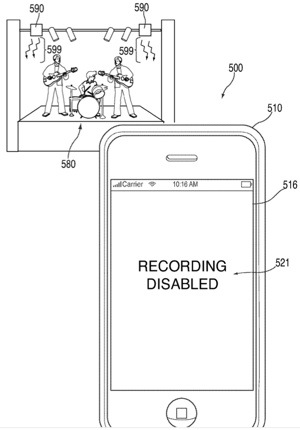An Apple patent for systems and methods for receiving infrared data with a camera designed to detect images based on visible light has popped up at the US Patent & Trademark Center.
Per the patent, a system can include a camera and image processing circuitry electrically coupled to the camera. The image processing circuitry can determine whether each image detected by the camera includes an infrared signal with encoded data. If the image processing circuitry determines that an image includes an infrared signal with encoded data, the circuitry may route at least a portion of the image (e.g., the infrared signal) to circuitry operative to decode the encoded data.
If the image processing circuitry determines that an image does not include an infrared signal with encoded data, the circuitry may route the image to a display or storage. Images routed to the display or storage can then be used as individual pictures or frames in a video because those images do not include any effects of infrared light communications. The inventors are Victor Tiscareno, Kevin Johnson and Cindy Lawrence.
Here’s Apple’s background and summary of the invention: “This is directed to infrared data transmission. In particular, this is directed to systems and methods for receiving infrared data with a camera designed to detect images based on visible light.
“Many electronic devices includes cameras designed to detect images. For example, a traditional cellular telephone or portable media player may include a camera. Such cameras can typically detect images based on visible light but do not receive any data communications through either visible or invisible light. Accordingly, the functionality of cameras in traditional electronic devices is limited.
“This is directed to systems and methods for receiving infrared data with a camera designed to detect images based on visible light. A system can include a camera and image processing circuitry electrically coupled to the camera. The image processing circuitry can determine whether each image detected by the camera includes an infrared signal with encoded data. If the image processing circuitry determines that an image includes an infrared signal with encoded data, the circuitry may route at least a portion of the image (e.g., the infrared signal) to circuitry operative to decode the encoded data.
“If the image processing circuitry determines that an image does not include an infrared signal with encoded data, the circuitry may route the image to a display or storage. Images routed to the display or storage can then be used as individual pictures or frames in a video because those images do not include any effects of infrared light communications.
“Based on the decoded data, a device can display information to a user or modify an operation of the device. In some embodiments, a device can, based on receive infrared data, display information to a user relating to an object near the user. For example, an infrared emitter can be located near an object and generate infrared signals with encoded data that includes information about that object. An electronic device can then receive the infrared signals, decode the data and display the information about the object to the user.
“In some embodiments, a device can, based on received infrared data, disable a function of the device. For example, an infrared emitter can be located in areas where picture or video capture is prohibited, and the emitter can generate infrared signals with encoded data that includes commands to disable the recording functions of devices. An electronic device can then receive the infrared signals, decode the data and temporarily disable the device’s recording function based on the command.”
— Dennis Sellers

